Sailing Signal Flags: A Comprehensive Guide
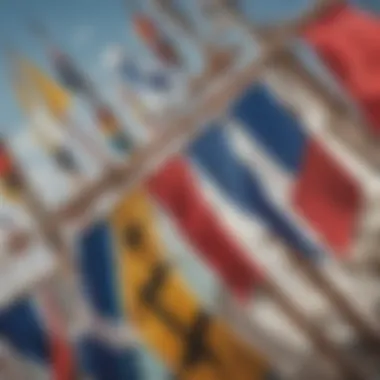
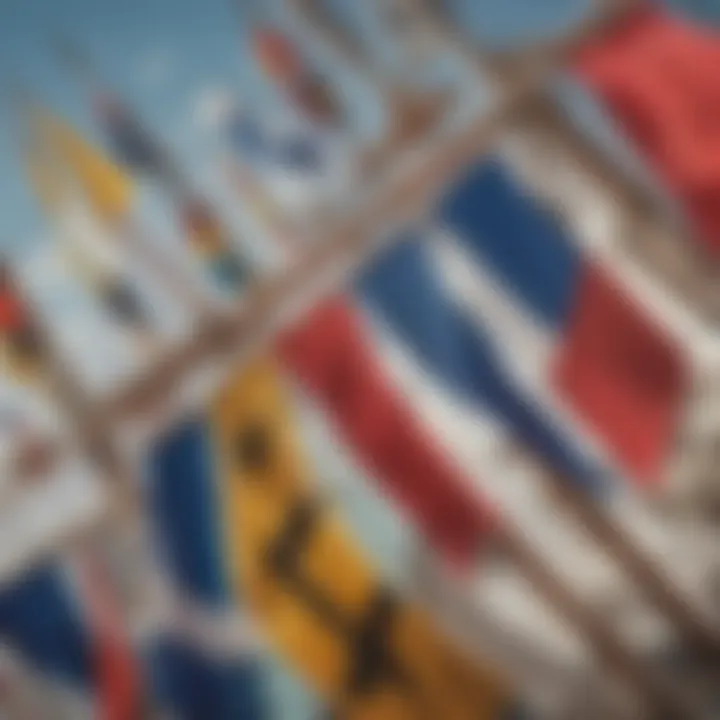
Intro
Navigating the open seas has always been an intricate dance—an interplay of human skill and natural forces. But beneath the surface of this seemingly intuitive activity lies a sophisticated system of communication that dates back centuries: sailing signal flags. These colorful pieces of fabric are not just decorative bits of cloth flying from masts; they carry significant meaning and are essential for ensuring safety and efficiency on the water.
Sailing signal flags can be traced back to ancient maritime practices, evolving into a robust language that transcends spoken words. Understanding this system is crucial for sailors, whether they're anchoring in a calm cove or maneuvering through busy shipping lanes. In this guide, we will unravel the fascinating world of signal flags, discussing their historical context, various types and meanings, and the practical applications that keep our waterways safe. This exploration serves both seasoned mariners and curious newcomers who wish to deepen their understanding of maritime communication.
As we delve into this topic, let's first touch on the essential gear that aids sailors in utilizing signal flags effectively.
Prolusion to Sailing Signal Flags
Understanding sailing signal flags is like unlocking a secret language that has guided seafarers for centuries. These colorful pieces of fabric carry crucial messages, making maritime communication clear, especially in the bustling environment of the open waters where every gesture counts. Whether you're an enthusiastic sailor or someone who dips their toes into the world of sailing occasionally, comprehending these signals is key to navigating safely and effectively.
Definition and Purpose
At its core, sailing signal flags serve as a means of visual communication on water. Each flag represents letters or specific messages, allowing sailors to send information across significant distances. This system is particularly beneficial when verbal communication is impossible due to noise or distance.
For example, if a vessel wishes to inform another vessel of its intentions, the appropriate flags can convey messages such as "I am altering my course" or "I require assistance." This form of communication is not just practical; it is a crucial safety measure. Keeping everyone informed helps avoid accidents or misinterpretations on the water. Basically, these flags act as a lifeline amidst the vastness of the sea.
Using flags has its advantages:
- They are universally recognized, reducing potential language barriers.
- Flags can be spotted from afar, even in challenging visibility conditions.
- They don’t rely on technology, making them a reliable option in case of equipment failure.
In today’s high-tech age, one might think that such traditional practices are fading. However, the use of signal flags still holds relevance. Sailors who understand these flags show a profound respect for maritime heritage and enhance their operational competency.
Historical Context
The roots of sailing signal flags stretch deep into maritime history, evolving alongside the very essence of navigation. Initially, sailors relied heavily on visible signals as a way to communicate across the water. Over centuries, as maritime trade expanded and countries competed on global waters, the need for standardized signals arose.
Colonial naval forces in the 17th century began to adopt flag systems, which later contributed to what we now recognize as the International Code of Signals established in 1900. This code encompasses flags that represent letters, numerals, and various standard messages.
Different nations contributed to this rich tapestry; for instance, the British Royal Navy popularized several flag signaling practices that many seafaring nations still utilize today. Ships of various nations often adorned distinctive flags, further adding layers to their operational protocol. This historical significance illustrates that sailing signal flags are not merely decorative; they are steeped in a long-standing tradition that continues to play a crucial role in maritime safety and coordination.
Through centuries of refinement, the flags used in sailing have become an integral element of nautical culture. Each flag not only embodies specific meanings but also acts as a symbol of the evolution of maritime practices aimed at fostering understanding and cooperation on the seas.
Types of Sailing Flags
Understanding the types of sailing flags is crucial for anyone who takes to the water. These flags serve as a language of their own, enabling sailors to communicate effectively without the need for verbal interaction. Each type plays a distinct role, whether it's expressing nationality, following international codes, or signaling during races. The flags convey important messages that can enhance safety and cooperation among vessels, making their study essential for both enthusiasts and seasoned mariners.
National Flags
National flags are an essential part of sailing culture. Each country has its own distinctive flag that is displayed prominently on vessels. The main purpose of these flags is to signify the nationality of the ship, which is crucial for legal and regulatory reasons. When a vessel is encountered on the open water, recognizing its national flag helps in determining the rules applicable for that ship.
Though it may seem straightforward, flying the correct national flag can have serious implications. For instance, flying a flag of convenience—using the flag of a country other than where the ship is registered—could lead to legal challenges. Furthermore, in times of distress, a ship’s national flag might attract attention for rescue, emphasizing its importance in maritime safety.
Some interesting facets about national flags include:
- Symbolism: Each flag embodies aspects of the nation's identity, from historical events to cultural elements.
- Design: The design can vary widely; some are colorful while others are quite simple, yet each tells its own story.
- Protocol: There are specific protocols for displaying these flags depending on the context, such as when entering a foreign port or crossing international waters.
International Code Flags
The International Code of Signals is a system that uses flags as a universal language among mariners around the globe. This code consists of a set of signal flags representing letters, numbers, and specific messages. With this system, ships can convey messages where verbal communication may be hampered by distance or noise.
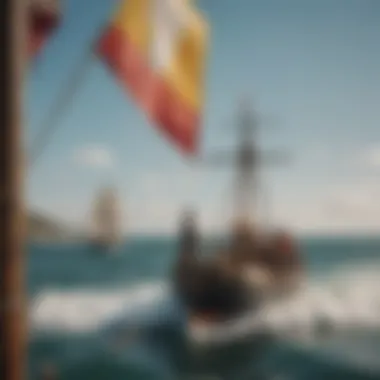
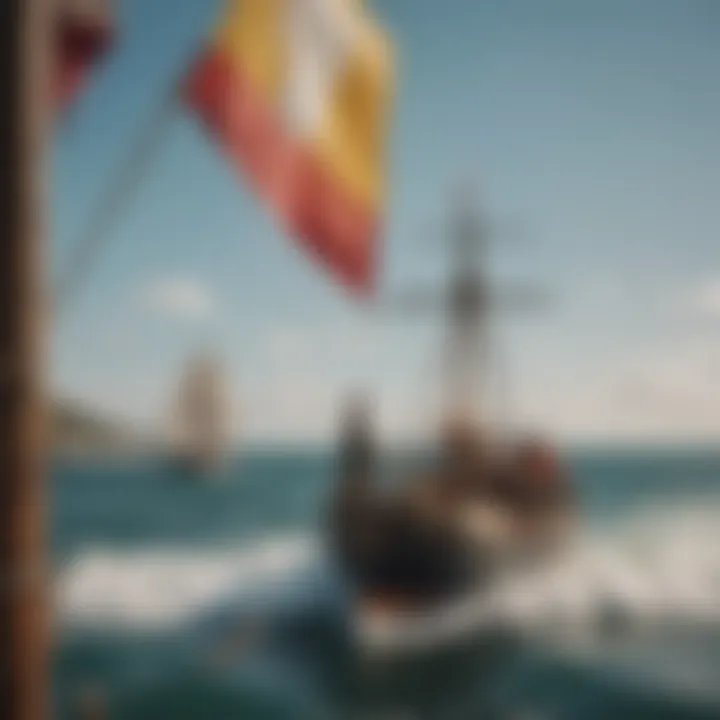
Each flag corresponds to a letter, and some flags hold specific states that might indicate distress or operational needs. For example, the flag “Bravo” signals that a vessel is taking on or discharging dangerous cargo, while the “November” and “Charlie” flags together ask if you are in need of assistance.
The flexibility and efficiency of this code have made it a fundamental part of maritime signalling. Key features include:
- Simplicity: Each flag is easily recognizable, making it straightforward to understand at a glance.
- Versatility: Ships can combine flags to send complex messages tailored to their specific situations.
- Global Understanding: Since many sailors come from different parts of the world, this standardized signaling promotes safety and collaboration on the open seas.
Regatta Flags
Regatta flags are another specialized set of indicators used during racing events. They are typically utilized to mark various race-related activities or conditions. For instance, a flag can signal when a race is about to begin or indicate when a certain rule is in play, such as a start delay.
Participation in regattas requires familiarity with these flags as they can drastically affect a sailor’s performance. Flags like the First Substitute signal a general recall, while distinctive colors and patterns often indicate wind conditions or specific requests from race committees.
The utility of regatta flags can be summarized as follows:
- Race Management: They help organize and facilitate the regatta smoothly, allowing everyone on the water to be on the same page.
- Competitive Edge: Familiarity with these flags can be the difference between winning and losing a race, as a sailor's ability to react efficiently to signals can ultimately dictate success.
"Knowledge of these flags is just as important as knowing your sails. Without it, you could be lost in translation on the water."
Understanding the types of sailing flags—national, international code, and regatta flags—provides sailors with the tools they need to navigate effectively and safely. These flags are not just colorful pieces of fabric; they are integral elements of maritime communication that enhance safety and camaraderie on the sea.
International Code of Signals
The International Code of Signals (ICS) stands as a cornerstone in maritime communication, transcending language barriers that can sometimes complicate interactions on the open water. Only through this system can sailors convey crucial messages effectively, ensuring safety and cooperation among vessels of all nations. Understanding the ICS not only strengthens the bond between mariners, but also fortifies navigation practices, as it equips crew members with the knowledge to react promptly to critical situations. Navigating through this complex world requires an appreciation for both tradition and modern necessity, as signals bridge the gap between disparate languages.
Overview of the Code
The International Code of Signals comprises a series of flags, each representing a letter of the alphabet and a corresponding word or phrase. What makes this code particularly noteworthy is its universal application, allowing various nationalities to communicate important messages efficiently in boat-to-boat scenarios, or between ship and shore. As the maritime world moves forward, the ICS ensures that even a novice sailor can engage in effective communication with just a basic understanding of the flags and their meanings.
Key Elements of the Code:
- Visual Signals: Flags can be seen from a distance, making them ideal for conveying messages when sound-based communication is unnecessary or impractical.
- Flexibility: The code is designed to transmit a variety of messages ranging from routine requests to emergency signals.
- Ease of Learning: It’s relatively straightforward; new sailors can quickly grasp the meanings behind the flags without extensive training.
Among other benefits, the ICS upholds navigational safety. In moments of crisis, such as during bad weather conditions or mechanical failures, the ability to communicate clearly and quickly can be lifesaving. Embarking on a journey through an unfamiliar route or shared waters can be daunting, but knowing the ICS can alleviate some of that anxiety.
Meaning of Each Flag
The following is a snapshot of the importance behind individual flags that comprise the International Code of Signals. Each flag not only holds a letter, but its use conveys an entire message crucial for seamless communication at sea:
- A - Alpha: "I have a diver down; keep well clear at slow speed."
- B - Bravo: "I am taking on or discharging explosives."
- C - Charlie: "Yes (Affirmative)."
- D - Delta: "Keep clear of me; I am maneuvering with difficulty."
- E - Echo: "I am altering my course to starboard."
Communication using signal flags opens a world of interaction, ensuring that every sailor understands, regardless of their native tongue.
- F - Foxtrot: "I am disabled; communicate with me."
- G - Golf: "I require a pilot."
- H - Hotel: "I have a pilot on board."
- I - India: "I am altering my course to port."
- J - Juliett: "I am on fire and have dangerous cargo on board."
The remaining flags follow a similar structure, with each one designed to provide specific, critical information. This kind of organized communication serves not just to foster cooperation among sailors, but also enhances safety when traversing busy waterways.
In summary, the International Code of Signals is an essential framework that enables sailors to communicate effectively and safely. Knowledge and understanding of these flags afford a practical skill set that every mariner should have under their belt, creating a more informed and safety-conscious maritime community.
Flag Hoisting Techniques
The ability to properly hoist a signal flag is not just a matter of tradition; it is essential for effective communication on the water. Correct flag hoisting allows sailors to convey important messages to other vessels, ensuring safe navigation and enhancing the efficiency of maritime operations. Knowing how to properly execute the hoisting technique can mean the difference between seamless communication and potential misunderstandings.
Correct Hoisting Procedures
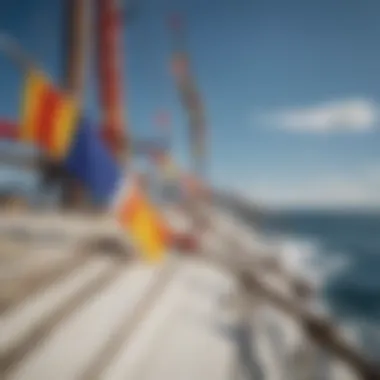
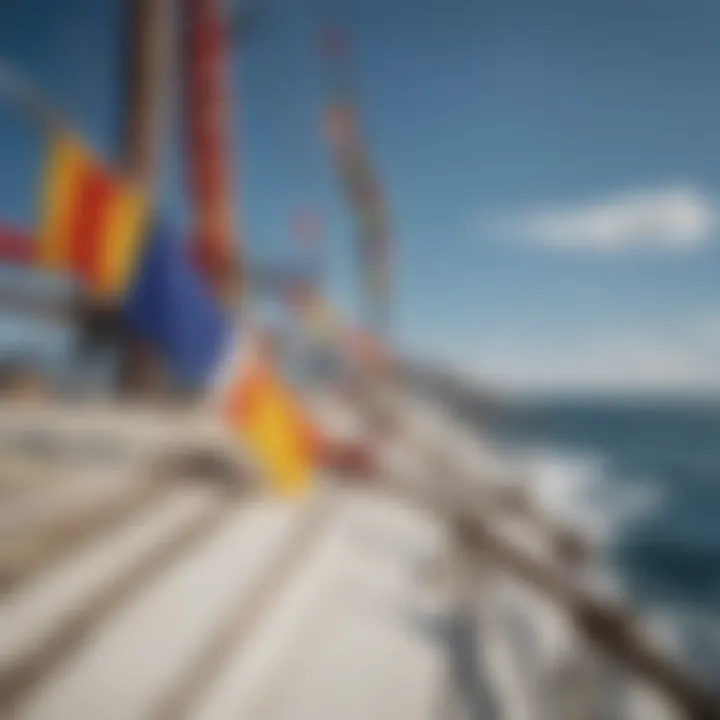
When it comes to hoisting a flag, proper techniques will make sure that the message being sent is clear and visible to all who might need to see it. Here are a few key considerations that accompany effective flag hoisting:
- Timing of Hoisting: Flags should be hoisted in a timely manner, ideally when in sight of the recipient vessel. This minimizes confusion, especially in high-traffic areas.
- Raising the Flag: To ensure clarity, a signal flag should be raised briskly in a straight line. A flag that flutters or hangs limply may not be
Practical Applications of Signal Flags
Signal flags serve an essential role in sailing, acting as a lifeline between vessels. They are not merely colorful pieces of fabric fluttering in the wind; they hold significant meaning and utility. In the vastness of the ocean, maintaining clear communication is crucial, and sailing signal flags underscore this importance in ways that one might not immediately recognize.
Communicating with Other Vessels
When it comes to sailing, it's all about establishing communication—even when you can't hear a single word spoken. Signal flags are the maritime equivalent of spoken language. Each flag represents a letter or a specific message, paving the way for direct exchanges between ships. For instance, the flags of the International Code of Signals are designed to convey frequent nautical messages, such as requests for assistance, confirmation of a ship's identity, or directions on navigation.
- Flag A (Alfa) indicates that a diver is down and other vessels should keep clear.
- Flag B (Bravo) signals that the vessel is taking on or discharging dangerous cargo.
Effective communication reduces the chances of confusion during critical navigation moments. When a vessel displays the signal flags appropriately, it allows others to easily interpret its status or intentions without ambiguity. It's also worth mentioning that sailors must be aware of local variations in flag meanings, as they can differ across maritime cultures.
Safety and Emergency Signals
Safety is paramount on the open sea, and signal flags significantly bolster this aspect. In a riveting environment where the stakes might be high, being able to convey critical messages swiftly can make all the difference. For example, if a ship runs into trouble, the appropriate emergency flag displays can alert nearby vessels that assistance is required.
Some critical safety flags include:
- Flag C (Charlie) requests assistance in case of distress or emergency.
- Flag N (November) alerts that a vessel is in need of medical assistance.
In the event of an emergency, displaying the right flags swiftly can spell the difference between dire consequences and timely help. Emergency signals cut through noise, enabling immediate awareness for nearby sailors. Moreover, understanding these flags—often seen in a gripping moment of urgency—is crucial for both novice and seasoned sailors alike,
Navigating the waters isn't just about staying afloat; it's about staying safe.
The practical applications of signal flags encompass many facets of maritime life. From day-to-day communication with fellow sailors to prompting swift responses in emergencies, the significance of these flags extends beyond mere symbolisms. By embracing the detailed language of sailing signal flags, one can enhance safety, cooperation, and understanding on the open sea.
Cultural Significance of Sailing Flags
Sailing signal flags serve not just as tools for communication on the high seas; they hold deeper cultural significance that resonates across different maritime communities. Understanding the anatomy of these flags unveils a world where seafaring tradition, national identity, and ceremonial practices intertwine. Each pennant often tells a story of its origin, its evolution, and its place in the hearts of those who navigate the waters.
Variations Across Different Nations
Around the world, the use of sailing flags varies significantly, with each nation adding its flavor to this age-old practice. For example, in the United States, nautical flags mainly communicate maritime operational procedures. However, venture into the waters off Japan, and you'll find an array of colorful flags used to denote various maritime festivals, which play a crucial part in local culture. Cultural signals permeate our seas, where flags are not merely markers but celebrations of heritage.
- American Signal Flags carry straightforward operational meanings relevant to navigation, safety, and maritime regulation. They fit well into a structured communication system that ensures every sailor understands the message, regardless of their background.
- In contrast, Italian maritime flags sometimes feature flamboyant designs that incorporate traditional elements, thus reflecting Italy’s rich history in seafaring and trade. These flags can often be spotted during regattas or local fishing competitions, invoking pride and camaraderie among participants.
This variation is crucial for sailors wishing to maintain respect and recognition for local customs while traveling. When one is aware of the differences in flag usage, it helps avoid embarrassing miscommunications. A sailor from Greece might interpret a flag differently from a sailor from Brazil, thus illustrating the cultural context surrounding these signals.
Ceremonial Uses
The ceremonial aspect of sailing flags can’t be understated. These flags are often flown during significant maritime events like regattas, ship launches, and even funerals for sailors lost at sea. It’s fascinating to see how these emblazoned fabrics become a focal point in rituals that embody both celebration and remembrance.
For instance, during ship-launch ceremonies, flags adorned with the vessel's name and the flag of the nation are often displayed prominently. This not only signifies the ship's official blessing but also strengthens the bond between the community and its seafaring entities. The colors wave proudly in the wind as a symbol of hope and future voyages.
Moreover, in the context of maritime funerals, the practice of draping the deceased sailor's casket with a ceremonial flag creates a poignant closure. It serves as a reminder of the sailor’s life and their love for the ocean. It signifies respect, honor, and the lifelong journey each sailor takes.
Flag Maintenance and Care
Maintaining sailing signal flags is not just about keeping them clean; it’s about ensuring that they serve their purpose effectively during critical moments on the water. The importance of proper flag maintenance cannot be overstated; neglecting this task can lead to tears, fading, and even complete loss of the flag's functionality. A weathered flag might struggle to convey the intended message, leaving mariners in a bind when clear communication is vital. Therefore, sailors must adopt a routine care regimen to preserve their flags in optimal condition.
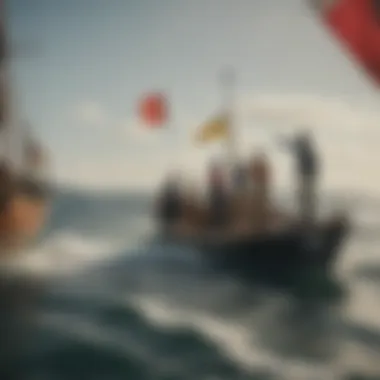
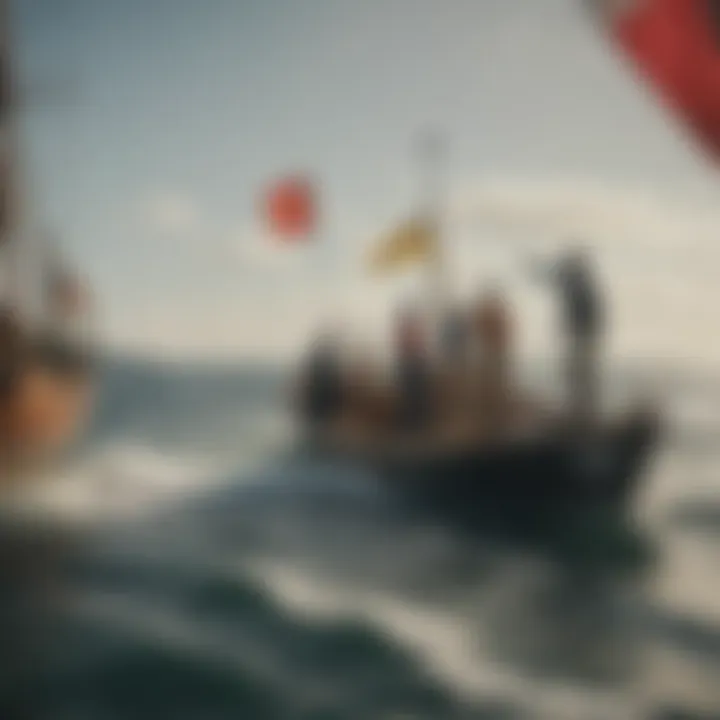
Best Practices for Preservation
Proper preservation of sailing signal flags includes a few straightforward yet essential steps. Here’s a rundown of best practices that can extend the life of your flags:
- Regular Inspection: Make it a habit to examine flags for frays, discoloration, and damage. If you spot issues quickly, you can often fix them before they escalate.
- Washing: Use mild soap and lukewarm water to clean flags, especially after heavy use or exposure to saltwater. Avoid bleach or harsh chemicals, as they can deteriorate the fabric.
- Drying: After washing, let flags air dry. Avoid wringing them out or exposing them to high heat, which can lead to shrinkage or distortion.
- Proper Storage: When not in use, store flags in a dry, cool place. Ideally, keep them rolled or folded loosely to prevent creases that can weaken the fabric.
Utilizing these best practices ensures that your flags remain vibrant and resilient, capable of performing their role whenever needed.
Repair Techniques
Even with diligent care, wear and tear are sometimes unavoidable in the rough maritime environment. Thus, having knowledge of basic repair techniques can be quite beneficial. Here are a few methods to consider:
- Sewing: For small rips or frayed edges, a simple sewing kit can work wonders. A needle and thread can patch up tears quickly, preventing further damage. Use weather-resistant thread if possible to enhance durability.
- Fabric Patches: In cases where damage is extensive, using fabric patches can be a practical solution. Cut a piece of similar or contrasting fabric, ensuring it’s securely sewn around the damaged area.
- Reinforcement: Applying extra stitching around the edges, especially on high-wear flags, can help extend their life. This reinforcement acts as a safeguard against fraying and further deterioration.
By adopting effective repair techniques, sailors can ensure their signal flags are always ready for use, maintaining the lines of communication critical for safe navigation.
"Proper care of sailing signal flags not only represents respect for maritime traditions but also enhances safety on the water."
In summary, taking care of your sailing signal flags is integral to their functionality and longevity. Consistent maintenance and prompt repairs can greatly enhance your sailing experience, ensuring that you’re always prepared to communicate effectively while out on the open water.
Future of Signal Flags in Sailing
The evolution of sailing signal flags is a testament to how maritime communication adapts to the times. While some may see signal flags as a relic of the past, the future holds significant promise for these vibrant pieces of fabric. As the maritime world continues to evolve with technological advancements, understanding this balance can be critical.
Technological Advances
With technology flourishing, one might wonder where that leaves the good old sailing signal flags. Well, they’re not going anywhere just yet. Modern advancements like VHF radios, satellite communication, and AIS (Automatic Identification Systems) offer faster means of communication. Yet, signal flags maintain a tactile charm and importance that technology can't completely replace.
For instance, using signal flags still proves useful in scenarios where electronic communication might fail or be forbidden, like certain traditional sailing events. Moreover, they cover various languages, serving a broad spectrum of mariners who may not be fluent in English, the universal maritime language.
"Sometimes, an old-school method can carry a weight that high-tech gadgets can’t."
Technology can assist with the learning and application of signal flags. For example, apps and online resources that gamify flag identification can help new sailors learn the ropes (or flags). Those tools can bring a modern twist to the age-old practice of flag signaling, maintaining its relevance.
Another promising area is the intersection of augmented reality (AR). Imagine sailing with an AR device displaying the meanings of flags you encounter! This could considerably enhance the learning experience for newbies while keeping seasoned sailors engaged.
Maintaining Traditional Practices
Even as we usher in new technology, it’s vital to hold on to the traditional practices surrounding sailing signal flags. Why? Because tradition grounds us. As much as we embrace the advancements, we should also cherish the distinctive nature of maritime language that signal flags represent.
One way to keep these traditions alive is through sailing schools and community events that actively teach flag signaling. When sailors pass on their skills, the younger generation gains insight into the meaning behind each flag, alongside why each signal matters. This mentorship ensures that the core of sailing communication does not fade away. It promotes camaraderie as sailors use flags together at regattas, showcasing their mastery.
On a broader scale, yacht clubs can host competitions where sailors can demonstrate their ability to read and interpret flags under pressure. This isn’t merely a nostalgic exercise; it reinforces the practical usage of signal flags in real-world contexts.
Furthermore, maintaining traditional practices also involves being mindful of how modern marine policies integrate signal flags. Keeping up-to-date with regulations ensures that sailors respect the timeless communication methods while embracing the new.
Culmination
Navigating the open waters involves more than just understanding wind patterns and engine mechanics; it also centers around effective communication among vessels. Signal flags, while perhaps overshadowed by modern technology, remain a vital part of maritime tradition. In this conclusion, we wrap our exploration around the importance and relevance of sailing signal flags within the context of safety, communication, and maritime culture.
Summary of Key Points
- Historical Significance: The roots of signal flags trace back centuries, showcasing how naval communication has evolved alongside sailing practices. Knowing this history offers insights into the present usage and purpose of these flags.
- Types and Uses: From national flags to international code flags, each category serves a distinct role. Signal flags function as a universal language, bridging potential communication gaps in multilingual maritime environments.
- Practical Application: Understanding the practical aspects of flag hoisting and signaling fosters safer interactions at sea. Whether sailors are communicating intentions or alerting vessels of emergencies, their proficiency in using signal flags is critical.
- Cultural Relevance: The diverse expressions of signal flags across various maritime cultures not only reflect their heritage but also underscore their place in ceremonial activities, adding a layer of richness to the sailing experience.
The Enduring Importance of Signal Flags
Even as digital technology emerges as a primary means for communication, sailing signal flags hold an enduring significance that goes beyond mere functionality. They embody centuries of maritime tradition and convey meanings that can prevent misunderstandings at sea.
- Visual Clarity: On the open water, where visibility can vary dramatically, bright signal flags stand out against the sky and waves, making them essential tools in gaining attention quickly and clearly.
- Cultural Heritage: Each flag carries a story and represents its country, encapsulating the spirit and values of its people. This cultural storytelling through flags promotes a sense of identity and connection among mariners.
- Continuous Relevance: Training new sailors in the art of reading and employing signal flags ensures this knowledge doesn't fade away in favor of technology. Passing on these skills helps to keep maritime traditions alive while also enhancing present-day safety.















